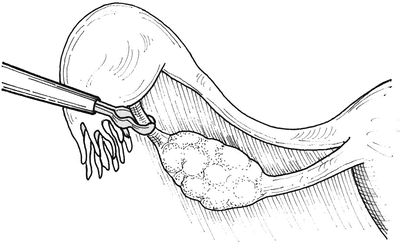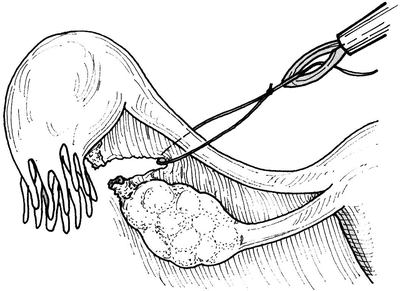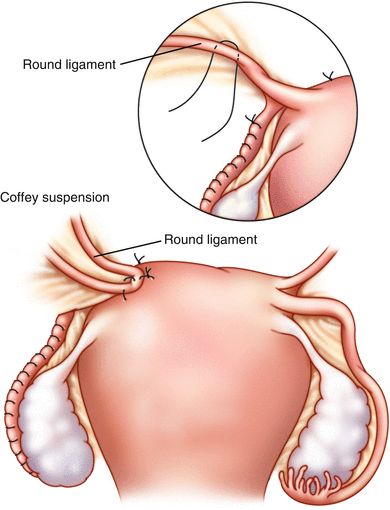Fig. 28.1
Algorithm for diagnosing ectopic pregnancy
In patients with hemodynamic instability or hematoperitoneum without a strong indication of an ectopic pregnancy, the possibility of other causes such as a ruptured ovarian cyst should be considered. In these cases, the use of an intrauterine manipulator during laparoscopy should be avoided to avoid interruption of an early intrauterine pregnancy. If needed a single-tooth tenaculum placed on the cervix can usually provide adequate uterine manipulation without risk.
Operative Strategy
The primary goal of all surgeries for ectopic pregnancy is to control bleeding, if present, and to remove the ectopic pregnancy. Secondary goals include preservation of fertility in those patients desiring for more children. Traditionally these surgeries were performed via laparotomy, but are now generally performed with laparoscopic techniques. Laparotomy remains the operative route of choice in situations where laparoscopy is unfeasible, or unavailable.
After operative exposure is obtained via laparotomy or laparoscopy, one must determine whether to attempt conservation of the affected tube in those patients desiring fertility. In patients with extensive tubal damage or uncontrolled bleeding, tubal removal is advisable. Likewise, unstable patients may be better served with tubal removal if tubal conservation will require prolonged surgery or continued blood loss.
In patients that are otherwise candidates for tubal conservation, the condition of the contralateral tube and the location and size of the ectopic pregnancy are determining factors. Expert opinions are divided on appropriate candidates. Salpingostomy may increase subsequent overall pregnancy rate at the expense of an increased ectopic rate. On the other hand, even normal appearing tubes may suffer from the same disease process as affected tubes as evidenced by the 15–20 % recurrent ectopic rate in patients with prior salpingectomy. As a rule, if the contralateral tube appears normal, salpingectomy may be a more appropriate option. The decision is based on the condition of the contralateral tube, the location of the ectopic pregnancy in the tube, and the ease of salpingostomy.
When feasible, laparoscopy is considered the preferred method for all but those with absolute contraindications or hemodynamically unstable. Even patients with massive hematoperitoneum that have been stabilized are frequently amenable to laparoscopic management. Particularly in patients with uncertain diagnosis, laparoscopy should be considered for diagnostic confirmation even if laparotomy will be required for treatment.
Potential Pitfalls
Ectopic pregnancy is frequently associated with dense pelvic adhesions that predate the ectopic pregnancy or result from intense inflammatory reactions seen with more chronic ectopic pregnancies. Laparotomy may be required to safely manage some cases. Injuries to surrounding structures may not be avoidable even with the best of surgical techniques but careful dissection and attention to anatomy should minimize these complications.
The most common general pitfalls are accidental ligation of the arterial supply to the ovary or removal of the ovary with the ectopic pregnancy. Preservation of the ovary is not always possible as the ovary may be the site of the ectopic pregnancy or become so encased in adhesions that safe removal of the ectopic pregnancy requires removal of the ovary as well. Although uncommon, ureteral injury can occur when the ectopic pregnancy is adherent to the pelvic sidewall. If necessary, the ureter can generally be identified above the disease process and dissection performed to free the ureter from the ectopic mass. Vascular injuries to the external and internal iliac can occur under similar conditions.
Postoperative Care
Postoperative care is generally straightforward and similar to that of any laparotomy or laparoscopic case. Unique aspects that may occur are discussed under those particular procedures.
Common Complications
Although not technically a complication, required removal of the affected tube when continued fertility is desired is not uncommon. This possibility should be discussed with the patient prior to surgery unless emergent surgery prevents full discussion. Persistent trophoblastic disease may require additional surveillance measures as well as further medical or surgical treatment and also should be discussed with the patient as part of the consent process or prior to discharge depending on circumstances. Additional details may be found in the subsequent sections.
When to Transfer
The presentation of an ectopic pregnancy is quite variable. With current diagnostic tools, ectopic pregnancy may be diagnosed in completely asymptomatic patient. Likewise, the patient may present with severe hypovolemic shock. In the latter, transfer is not an option and emergent surgery is required to preserve life. However, even when hypovolemic shock is present, many patients with ectopic pregnancy will stabilize rapidly to fluid and blood replacement. Transfer may still be possible in selected cases. The decision to transfer will depend on the facilities available, the training of the surgeon, the stability of the patient, and the distance to the accepting medical facilities. The emergent treatment of the typical ectopic pregnancy is within the skill set of any surgeon who performs routine abdominal surgery and should be possible at any facility that performs these surgeries/a surgery.
Salpingectomy (Figs. 28.2, 28.3, and 28.4)

Fig. 28.2
Laparoscopic division of mesosalpinx of fallopian tube

Fig. 28.3
Laparoscopic ligation of fallopian tube

Fig. 28.4
Coffee suspension to cover cornual resection of uterus
Indications
Patient does not desire future fertility
Patient desires complete tubal removal
Extensive tubal damage discovered at the time of surgery
Operative Strategy
Salpingectomy is the simplest and most rapid of the surgical procedures for the treatment for ectopic pregnancy. Thus it remains the procedure of choice in unstable patients and those with excessive ongoing bleeding. This procedure is easily performed by both laparotomy and laparoscopy. The ovary and its blood supply, the infundipulopelvic ligament are identified to avoid accidently removing the ovary or interrupting its blood supply. The mesosalpinx is divided by any of the several methods followed by transection of the proximal fallopian tube.
Operative Technique
The pelvis explored and the ectopic pregnancy identified. Rarely bilateral hematosalpinx are present and the exact location of the ectopic pregnancy is not obvious. In these cases, the tube may be opened as discussed in the section on salpingostomy to confirm the tube containing the ectopic pregnancy. The fallopian tube is retracted medially and the location of the ovary and the infundipulopelvic ligament is identified. If the surgery is performed via laparotomy, the mesosalpinx is sequentially clamped and divided with each pedicle suture ligated. The final clamp is placed across the proximal fallopian tube. If the surgery is performed via laparoscopy, segmental coagulation and division of mesosalpinx and fallopian tube is performed starting at the distal end of the fallopian tube. This may be performed with minimal instrumentation using a bipolar coagulation instrument and division with laparoscopic scissors or placement of suture endoloops around the fallopian tube followed by excision with laparoscopic scissors. Alternatively, any of the combination coagulation and division instruments may also be used. Laparoscopic stapling devices can be used; however, even with vascular loads, the thin mesosalpinx is prone to bleeding. The fallopian tube and products of conception are then removed within an endoscopic pouch.
Stay updated, free articles. Join our Telegram channel

Full access? Get Clinical Tree








